Esteban Chaves: Behind the smile
A look at the Colombian's rise as a Grand Tour rider
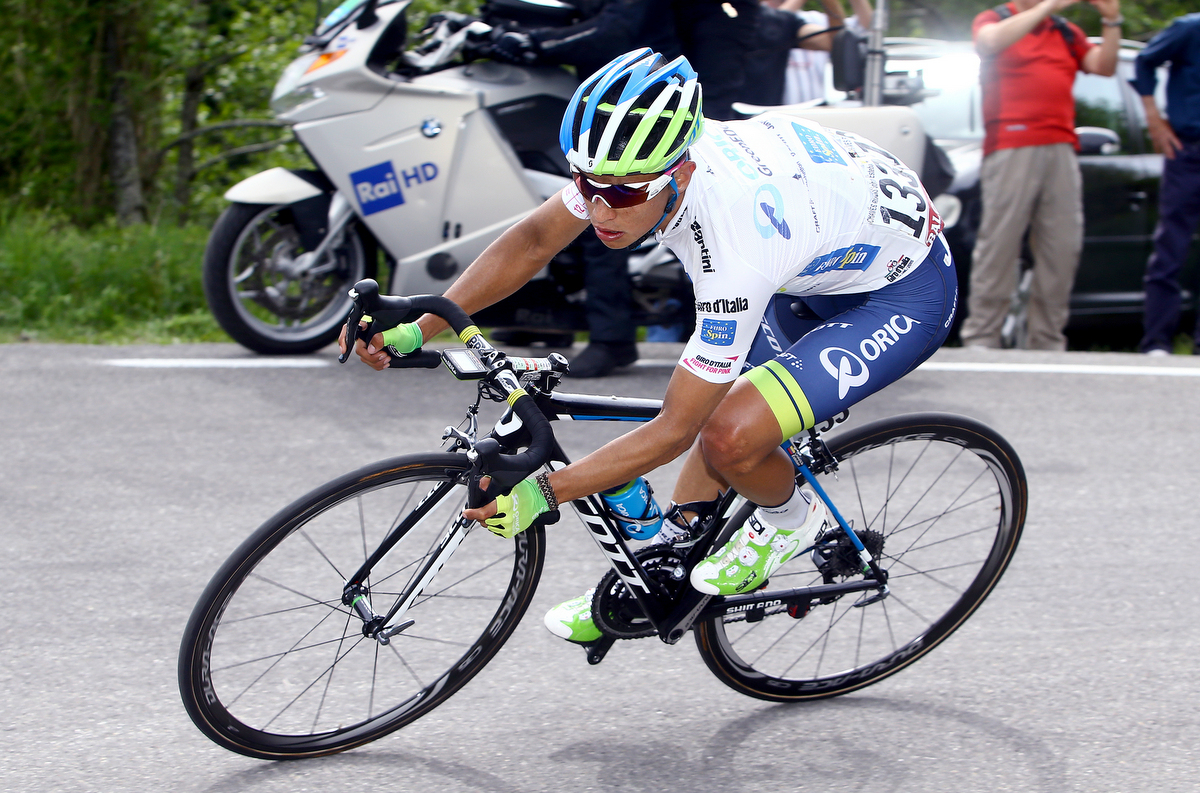
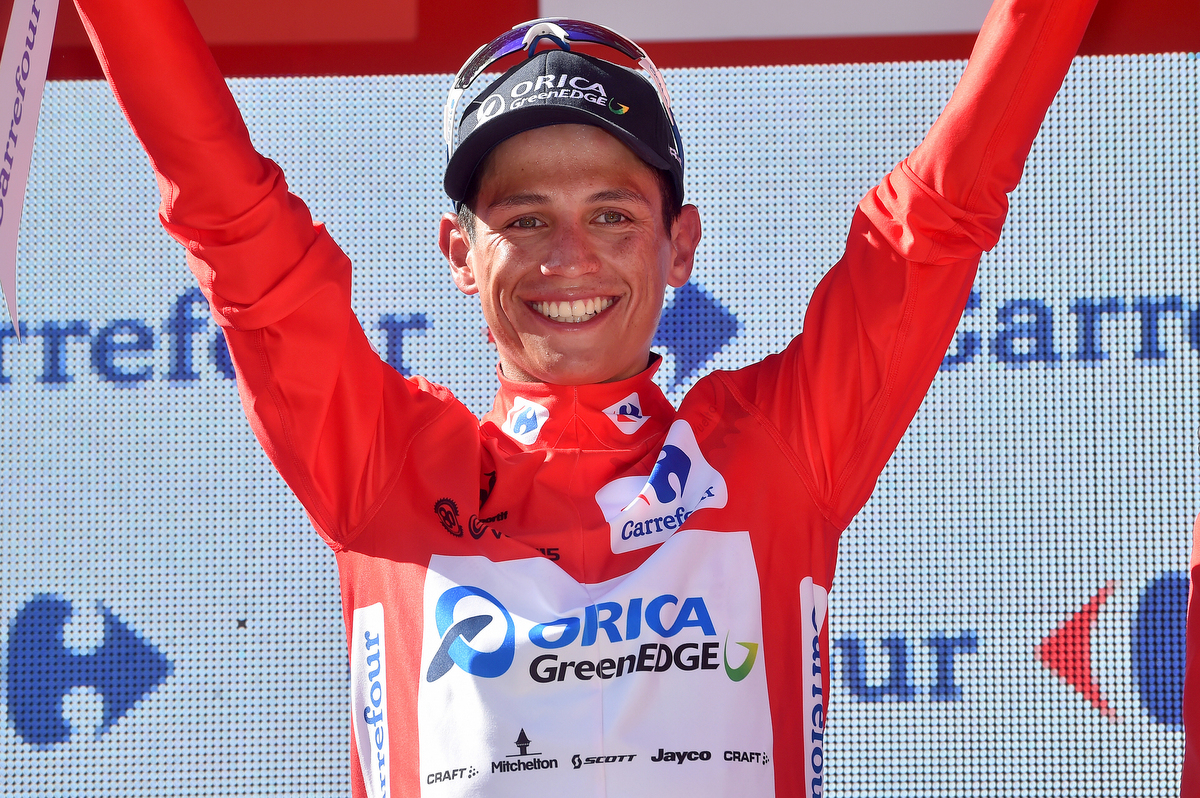
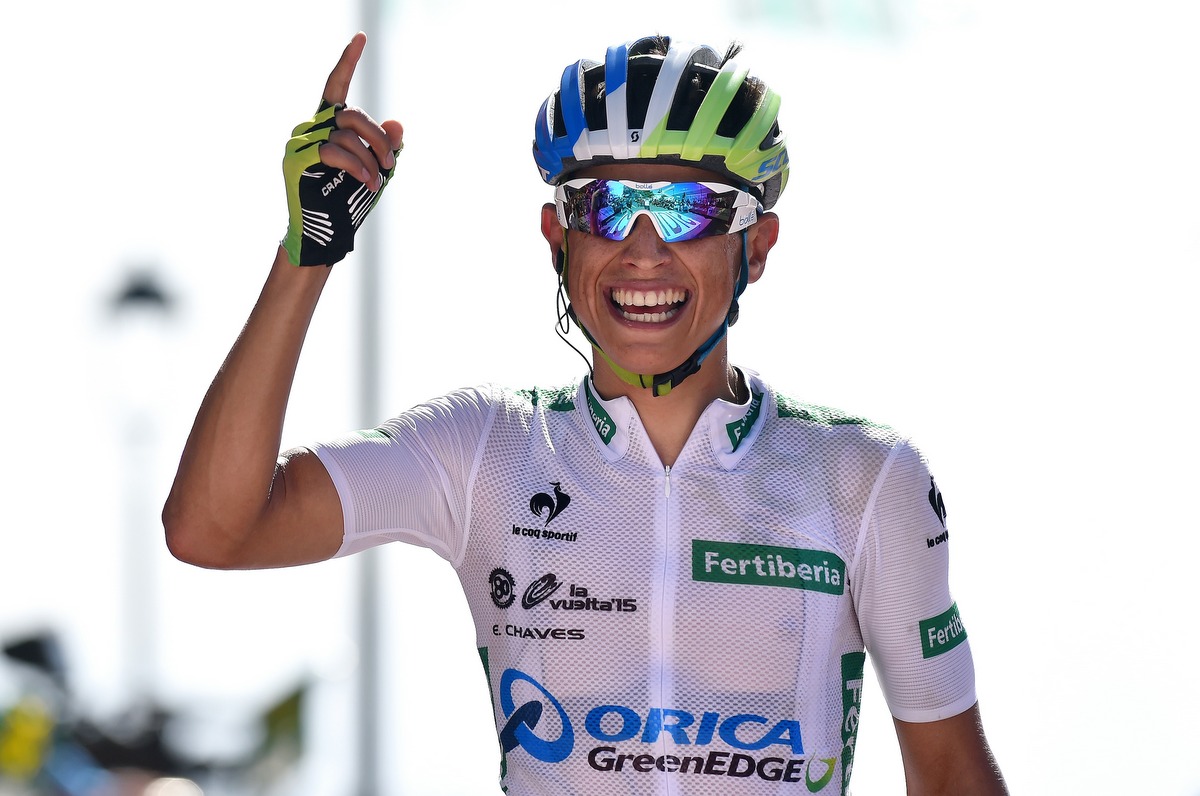
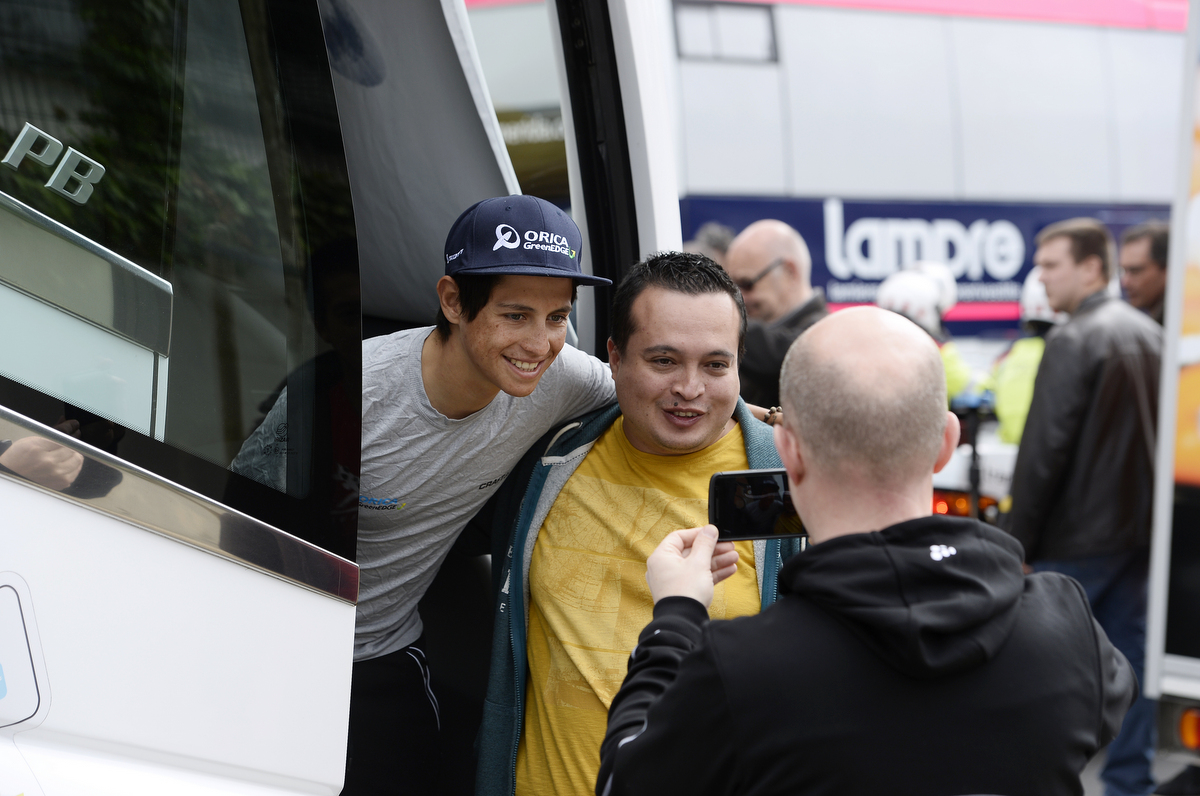
Esteban Chaves is two weeks into his first start in the Giro d’Italia. It is almost a year ago, and the Colombian, while exhausted like all in the peloton, is still chirpy and looking ahead to the final days in the mountains with optimism.
With his first Grand Tour being the 2014 Vuelta a Espana, and the 2015 Giro his second three-week race, Chaves is in phase two of his development into a Grand Tour rider, a journey that he openly declares while talking with Cyclingnews will hopefully lead to him one day winning the Tour de France.
“This is the dream, to stay three weeks at a really good level and win the Tour de France one day – why not?” Chaves says with his trademark smile. “When I started at 13 years this was my big dream, to win the Tour. It’s not impossible, no?”
But first things first, Chaves, then 25, realises he has a long way to go. For starters, he knows he has to finish a Grand Tour strongly in the third week, unlike at the Vuelta where he was in the fray overall for the first two weeks but faded in the last. The week awaiting the Orica-GreenEdge rider as he talks in his first Giro is expected to be brutal, but full of opportunity.
“I’m really tired, but that’s normal,” says Chaves, adding that he is racing at the Giro “to learn, to make my body stronger.”
His goal for the last week is to try and get into a break in the mountains, rather than go with moves that include the overall contenders for the race leader’s maglia rosa like Spaniard Alberto Contador (Tinkoff) or Italian Fabio Aru (Astana).
As he speaks, you could be forgiven that he is not putting too much pressure on himself, especially when he reveals his preference not to study the next stage route closely until the morning of it and when he gets onto the team bus for the start.
Get The Leadout Newsletter
The latest race content, interviews, features, reviews and expert buying guides, direct to your inbox!
“I have my book in the bus, not in the room,” Chaves says. “I don’t know what the next stage is. I wake up, go to the bus, take my book and go, ‘climbers stage,’ or ‘a sprinters stage.’
“I look [at it] a little bit but not really a lot, or close.”
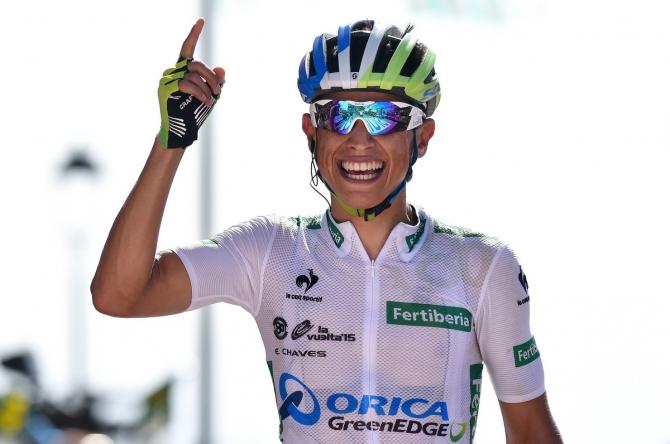
As the next week unfolds, Chaves gets into various moves and finds himself in animated phases of the Giro as the final battle for overall victory is fought between Contador and Aru.
In a race that was eventually won by Contador, by 1 minute 53 seconds over second placed Aru, Chaves finishes 55th overall at 3h 1m 37s. Okay, with no stage win or a podium finish, but plenty of experience and knowledge that he can race well and hard for the duration of a Grand Tour.
He then reaps the rewards of that performance three months later when he returns for phase three of his grand plan as a Grand Tour rider. That being a second crack at the Vuelta a Espana, in which he wears the overall leader’s red jersey for a total of six days from two spells in it, is victorious in stages 2 and 6, and finishes fifth overall at 3m10s to the race winner.
It is no surprise that before the Vuelta finishes, Chaves’ contract with Orica-GreenEdge - initially for two years from 2014 to 2015 - has also been extended by three to the end of 2018.
Then, after an eighth place in Il Lombardia, Chaves signs off on his 2015 season in October by winning the Abu Dhabi Tour overall as well as one of its four stages.
The goal: Top 10 in the Giro d’Italia
Fast forward to now. Phase four of his development beckons, the Giro d’Italia that starts in Apeldoorn in the Netherlands next Friday; and Chaves is being thought of in a different light. If not by his team, which has supported and planned his progression to where he is, then by his peers in the peloton. Orica-GreenEdge may wisely play down his objectives – at least in public - with head sports director Matt White telling Cyclingnews on the eve of Sunday’s Liege-Bastogne-Liege: “We can be realists. Our goal for Esteban is for a top 10.”
But who knows? In a Grand Tour laden with so much unpredictability because of the changing conditions, the podium or top five finish is not out of the question – perhaps even better, in a field wide open for contenders this year. White is not discounting anything, even though he concedes that for a Giro in which Orica-GreenEdge will also seek to help Australian sprinter Caleb Ewan win stages it will be hard for the Australian team to do that and go for an overall win.
“We are not going realistically to win the Giro,” says White, yet to announce his Giro team. “If you are going in to win a Grand Tour it’s got to be all about that one person. It’s pretty hard to share goals and objectives when you’re going in to win; but to finish maybe on the podium, top five or top 10. We can send a team to cater for Caleb at the same time.”
Chaves should be confident Orica-GreenEdge will field a strong team to suit he and Ewan. After all, Orica-GreenEdge did so for last year’s Vuelta in which Ewan also won a stage.
As much as Chaves is a potential jewel for Orica-GreenEdge with his Grand Tour potential, he has remained indebted to the team since it signed him up at the end of 2013. He made the move from the Colombia-Coldeportes professional team despite his future being in serious doubt after a crash during the Trofeo de Laigueglia in Italy in February that year. In the crash, he suffered brain trauma, and fractures in his right collarbone, the petrous and sphenoid bones (at the base of the skull) and his right cheekbone was damaged, his sinuses and numerous abrasions. Another diagnosis revealed a fractured jaw, broken inner ear bones, and torn quadriceps. It was later discovered that his axillary nerve was torn apart and the suprascapular nerve partially so from his arm being pulled so far back.
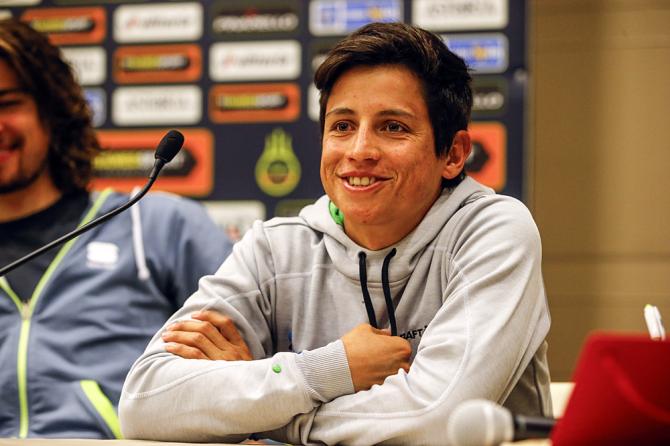
Chaves was a hot signing interest by then. He won the 2011 Tour de l’Avenir overall in his second of two years on the Colombia es Pasión–Coldeportes amateur team. Then with Colombia-Coldeportes in 2012, his first year as a professional, Chaves won a mountain stage of the Vuelta a Burgos and the Gran Premio Città di Camaiore one-day race and also finished in sixth place in the Under 23 world road race championship.
But with him requiring a second operation in Bogota on his right arm that had lost movement that lasted nine hours for nerves to be taken from his foot to replace the damaged ones, and then having to face three months of rehabilitation, Orica-GreenEdge could easily have backed out. The team did not.
When Chaves signed with Orica-GreenEdge in October 2013 on a two-year deal, he spoke no English; but quickly learned the language – albeit much of it Aussie vernacular – and adapted to their ways and philosophy.
“They are like Colombians – really relaxed, but when it is time to work we work,” says Chaves during last year’s Giro, then adding with a laugh when asked how he has adapted to the Australian accent: “The accent … yeah, good question. When I speak to an Australian, I know he is an Australian.”
White has no doubt that Chaves has adapted to the team, on and off the bike: “I don’t think he would have had much chance of succeeding on this team otherwise.”
The preparation: High altitude in Colombia
White is also confident that Chaves will be race ready for the Giro when he returns from Colombia where he has been training at high altitude at and near his home in Bogota since his last race, the Volta a Catalunya that finished on March 27.
Accompanying Chaves for the duration of his training block has been Orica-GreenEdge sports scientist Marc Quad.
“Esteban has a really good network of people there,” White says. “All the Colombians come from home in a great place. “Colombians are generally family people. It is a great environment before they return for a big stint in Europe.”
White has also believes Chaves has greater focus thanks to his step up at last year’s Vuelta. “Where we saw the change was at the Vuelta,” White says. “His results this year, they have been okay, a little bit under where he would have liked, but I can see the focus is really on two big races – the Giro and Vuelta. Speaking to him [last week] – he is in a good place mentally. He has put in a lot of hard work the last couple of weeks. He will be ready to lead the team in the Giro.”
Chaves, who lives in Girona, Spain when in Europe, believes his home roads in Colombia are by far the best to train on. Add the ideal temperature that Chaves says is 18C degrees.
“The altitude is unbelievable,” Chaves says. “I live at 2,500 metres. I have 200km [of roads] at this altitude. And I can train in higher altitude with climbs that finish at 3,500 metres. There are not so many roads – maybe three, four or five roads - but at 2,500 metres you live, sleep and train at this altitude.”
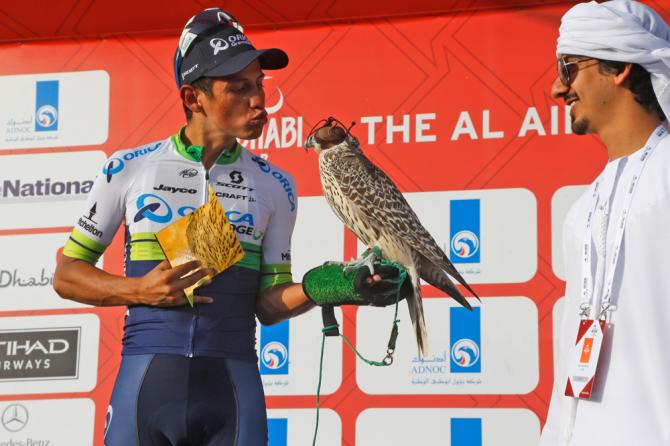
The hours spent training in the mountains and at high altitude should pay dividends in the Giro. White says it will be made harder than the Vuelta by the probability of wet weather or snow due to a “late winter in Europe” in the last week when the race passes through the Dolomites and Alps, and the sheer amount of climbing in the Giro compared to the Vuelta.
White says Chaves would carry out a final reconnaissance of the Giro’s mountains before heading to Apeldoorn for the start.
“The hardest stage of the Vuelta last year, the Andorra stage went to over 4000m of climbing and this year in Giro there are four or five stages with more metres of climbing than that,” White says. “It’s a lot heavier [for climbing] than the Vuelta and the Tour de France. The mountain stages of the Giro are a lot more physically demanding than the Tour.”
Chaves may not welcome the prospect of the cold when wet weather strikes in Europe where, he says: “When it rains it is very cold, when it rains in Colombia you don’t need a jacket.”
But having now raced the Giro, he will know what to expect. Ahead for him is another chance to take his career further. With that, Orica-GreenEdge’s evolution from being a team that began with pinning hopes on sprinters and opportunists but is now developing into a team that can serve the new grand tour contenders, with the British twins Simon and Adam Yates, who are not racing the Giro, also on the roster.
The start: where and how it all began
Chaves smiles when asked how his career has unfolded compared to that of Quintana who is less than a month younger and who he helped win the 2010 Tour de L’Avenir as a teammate on the Colombia es Pasión–Coldeportes team.
“In Colombia, we have a saying: ‘Not all fruit matures at the same time,’” explains Chaves softly. “It is a country with oranges, but not all the oranges are ready at the same time.”
Chaves' pathway to the bike was virtually created by chance. His father, Jairo and a sports lover whose business is to build wooden furniture, and mother Carolina did not directly steer him towards cycling. They just encouraged him to pursue his passions in life, which in sport included running that he was drawn to by watching it in the Olympic Games on television.
Although, he does recall watching the men’s road race at the 1995 world road championships in Colombia at the age of five and witnessing Spaniard Abraham Olano win “with a flat tyre,” leaving Spaniard Miguel Indurain and Italian Marco Pantani to settle for the respective silver and bronze medals.
“But then one time I raced in duathlon and said, ‘I want to do this (cycling),’ recalls Chaves of his switch to cycling.
He was 13, joined a cycling club and then rose up the ranks to compete at the national titles, the Pan American Games and then race internationally towards his breakthrough Tour de l’Avenir where he emerged as a professional team prospect.
Chaves did not have any one hero to try to emulate. There was no poster pin-up in his room. He took a leaf from many riders, but he did not wait for his career to soar as it has before putting something back into the sport that is now his job. With his father and younger brother Bryan, he set up the Club de Formacion Ciclistica Esteban Chaves, a development club which Chaves says has “good riders,” before then adding: “When they are at a really good level they go to another team.
“We are the first part of the process, a development team.”
Chaves is also a part of that process in Colombian cycling. His career is a work in progress at a time of high expectation for Colombian cycling with a generation that includes Quintana, Rigoberto Urán, and Carlos Betancur, Julian Arredondo and the Henao cousins Sergio and Sebastian.
How many of those expectations Chaves may be able to match, is a question that this year’s Giro may well answer.
Rupert Guinness first wrote on cycling at the 1984 Victorian road titles in Australia from the finish line on a blustery and cold hilltop with a few dozen supporters. But since 1987, he has covered 26 Tours de France, as well as numerous editions of the Giro d'Italia, Vuelta a Espana, classics, world track and road titles and other races around the world, plus four Olympic Games (1992, 2000, 2008, 2012). He lived in Belgium and France from 1987 to 1995 writing for Winning Magazine and VeloNews, but now lives in Sydney as a sports writer for The Sydney Morning Herald (Fairfax Media) and contributor to Cyclingnews and select publications.
An author of 13 books, most of them on cycling, he can be seen in a Hawaiian shirt enjoying a drop of French rosé between competing in Ironman triathlons.